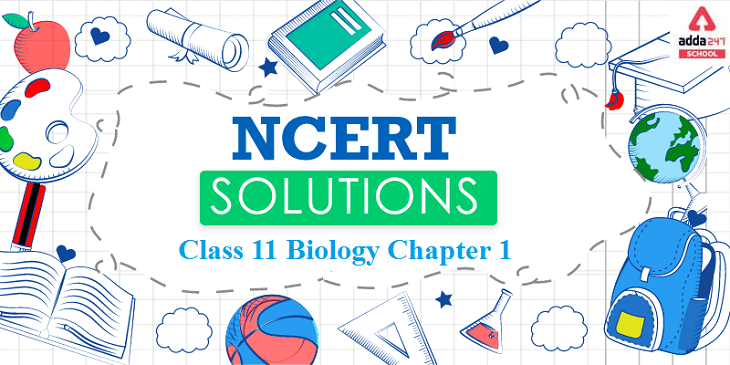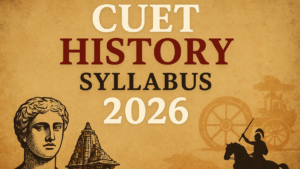NCERT Solutions for Class 11 Biology Chapter 1 in English
Adda 247 provides NCERT Solutions for Class 11 Biology which is for the students who want to go ahead in life and achieve great marks in their examinations. The NCERT Solutions are provided by the teachers who are experts of their subjects. The solutions are set according to the rules formulated by the NCERT and in the language that can be understood by every student. By reading the solutions students can build up a strong base easily. The NCERT class 11 Biology solutions cover chapters 1 to 22 with the important questions and the answers in a detailed way.
Examinations can be threatening for some people, a proper learning of the concepts is the key to crack the examination. Students rely on the solutions of the NCERT provided by Adda 247. The solutions are formulated by the experts of the subjects who have tremendous knowledge in their subjects.
These NCERT Solutions help the students to get familiarized with the textbooks. The students can access the solutions anywhere while browsing the web easily. The solutions are very precise and accurate.
NCERT Solutions for Class 11 Biology Chapter 1 – The Living World
The chapter provides information about The Living World. Earth has numerous habitats with a wide range of living organisms inhabiting it. Living organisms show a variety of unique characters which are different from non-living matter. Classification is the process by which anything is grouped in a convenient category based on some easily observable characters.
[sso_enhancement_lead_form_manual title=”Download Full PDF of Class 11 Biology Chapter 1 ” button =”Download Now” pdf =”/jobs/wp-content/uploads/2021/06/08174520/English-chapter-1.pdf”]
The living organisms are arranged in taxonomy. R. H. Whittaker proposed the five-kingdom classification. Three domain classification was proposed by Carl Woese and his co-workers.
The taxonomical hierarchy includes seven categories namely kingdom, phylum, class, order, family, genus, and species. Nomenclature is the process of assigning scientific names to animal or taxonomic groups. Each scientific name has two components, a generic name, and a species name. The important component of the taxonomical tools is field visits, survey, identification, classification, preservation, and documentation. Molecular taxonomical tools are more accurate, authentic, and significant for taxonomical classification.
Features of the NCERT Solutions for Class 11 Biology Chapter 1- The Living World
- NCERT Solutions have been answered based on the important information on the question.
- The columns are used wherever necessary.
- Solutions are solved point-wise and accurately answered point to point.
Ncert solution for class 11 Biology Chapter 1: The living world Important Questions & Answers
Question 1. Why are living organisms classified?
Answer: There are a large number of plants, animals, and microbes on
the earth and they might differ in size, shape, color, adaptations, and
many more characters. Studying each of them independently is different,
therefore scientists have developed mechanisms to classify the
organisms on the basis of certain rules and principles. On the basis of
rules, the organisms are classified into different groups.
For example, on the basis of the presence of three pairs of legs and two
pairs of wings, the organism can be identified as an insect.
Classification helps in establishing and revealing the relationship
between the different organisms.
Question 2. Why are the classification systems changing
every now and then?
Answer: There are millions of plants, animals, and microorganisms on
the earth. Many of the species have been identified while some of them
are still being discovered. New species are constantly evolving with new
characteristics, new classification has to be devised every now and then.
At first, the classification was based on morphology and after
morphology, embryology was taken into account, then phylogenetic
relationship and cytology were considered. The latest classification
method considers biochemical techniques to classify the organisms on
the basis of the nucleic acid structure
Question 3. What different criteria would you choose to classify people that you meet often?
Answer: The criteria for classification will be based on first, their name
and morphological characters such as skin color, height, sex. Other
than morphology, we can consider education, profession, area, hobbies.
Question 4. What do we learn from the identification of individuals and populations?
Answer: By the identification of individuals and populations we can learn
about their native place, mother tongue, costumes, food habits, religion,
caste , etc. We learn about the scientific names and descriptions of the
organisms. The similarities and dissimilarities help scientists to
classify organisms in different groups.
Question 5. Given below is the scientific name of Mango. Identify the correctly written name.
Mangifera Indica Mangifera indica
Answer: The correct option is Mangifera indica where, Mangifera is the
genus and indica is the species. The genus name starts with capitalized
alphabet and the species name starts with lowercase alphabets. Both genus
and species names must be italic.
Question6. Define a taxon. Give some examples of taxa at different hierarchical levels.
Answer: A unit or category of classification is known as a taxon. It is a
level or rank. The basic level is species while the highest level is
the kingdom.
The taxa at different hierarchical levels are:
a. Kingdom
b. Phylum
c. Class
d. Order
e. Family
f. Genus
g. Species
Question 7. Can you identify the correct sequence of taxonomical categories?
a) Species Order Phylum Kingdom b) Genus Species Order
Kingdom c) Species Genus Order Phylum
Answer: (a) and (c) signify the sequence from bottom to the topmost
hierarchy.
Question 8. Try to collect all the currently accepted meanings for the word ‘species’. Discuss with your teacher
the meaning of species in the case of higher plants and animals on one hand, and bacteria on the other hand.
Answer: Species are the organisms having the same type of characters and
features which are grouped together.
A group of individuals having fundamental similarities are called species.
For example, Panthera leo and Panthera tigris, where Panthera is the
genus but Leo and Tigris are species.
Question 9. Define and understand the following terms: (i) Phylum (ii) Class (iii) Family (iv) Order (v)genus
Answer:
Phylum: It is the second-highest unit of classification after the Kingdom.
It possesses one or more related classes of animals. The term ‘division’
can also be used.
Class: It is a taxonomic group having one or more related orders. For
example,
presence of notochord. Class Mammalia includes orders like Primates,
Carnivora and
so on.
III. Family: Taxon having the organisms with similar genera. It has one
or more related
genera. For example, families can be categorized on the basis of
vegetative and
reproductive features.
IV. Order: The taxa having one or more related families. The order
Carnivora has many
families.
V. Genus: It is a group of similar and related species which have
many characters in common.
It is placed above the species and below the family.
Question 10. How is a key helpful in the identification and classification of an organism?
Answer: Key is a lead which is a type of taxonomical aid which helps in
identifying plant and animal species. The keys are based on similarities
and dissimilarities. It generally occurs in the couplet. It can also identify
unknown organisms.
Keys can be of two types – indented and bracketed. Indented keys
provide the order of choices between two or more statements while in
the bracketed key, a pair of contrasting characters is used.
Frequently Asked Questions on NCERT Solutions for Class 11 Biology Chapter 1
1. What are the advantages of referring NCERT Solutions for class 11 Biology chapter 1?
Students referring to the NCERT Solutions by Adda 247 find the solutions helpful during the exams. The solutions are prepared by the experts in an interactive manner keeping in mind the students. The students’ perspective is kept in mind while preparing the solutions. It helps in completing the syllabus on time and also provides notes for the revision prior to the exam.
2. What are the advantages of referring NCERT in competitive exams like JEE and AIPMT?
Most of the competitive exams like NEET, JEE, etc. follow the basic NCERT books for designing their question papers. NCERT serves as the base for every book prepared for NEET and JEE. The competitive exams are based on the CBSE syllabus applied in XI and XII classes and NCERT books strictly follow the CBSE syllabus. In addition to this, NCERT books play an important role in clearing out the theoretical concepts. Every topic given in NCERT books is explained in such a way to help students make their basics and fundamentals strong and clear.
3. How to read NCERT books more efficiently?
Given below are the important points which must be followed while reading the NCERT books in an efficient manner:
Go through each topic thoroughly by understanding the meaning and significance of each line mentioned in that particular topic.
Ask your teacher if any doubts.
Note down the important topics to revise at the time of examination.
Solve all the exercise questions given at the end of each chapter. These questions are important for understanding the concepts in a better way.
4. Is it mandatory to solve all the NCERT questions mentioned at the end of each chapter?
The questions and answers mentioned in NCERT textbooks at the end of each chapter are quite important not only for examination but also for understanding the concepts in a better way. These questions aim to test the students’ understanding and learning over the topics that they have learned in the chapter.
Solving the NCERT exercise problems will help to
- clear all the concepts and formulae you learned in a chapter
- get comfortable with different types of questions that might be asked in exams
- get enough practice which is key to succeed in the Mathematics exam
- improve your accuracy and speed
5. What are the important concepts covered in Chapter 1 of NCERT Solutions for Class 11 Biology?
The concepts involved are –
1.1 – What is Living?
1.2 – Diversity in the Living World
1.3- Taxonomic Categories
1.4 – Taxonomical Aids
These concepts are created by the faculty at Adda 247. The solutions are available at Adda 247 in PDF format which can be downloaded by the students.










 CBSE Date Sheet 2026 for Class 10 & ...
CBSE Date Sheet 2026 for Class 10 & ...
 CBSE Class 10 Date Sheet 2026, Check 10t...
CBSE Class 10 Date Sheet 2026, Check 10t...
 CUET History Syllabus 2026 (Updated), Do...
CUET History Syllabus 2026 (Updated), Do...














